Nano Cupcakes
For a while carbon nanotubes have been a hot topic in science. Some of the latest research on nanotubes done at the US National Institute of Standards and Technology in Boulder, CO are fondly called Cupcakes,1,2 but you may only want a mental bite of these!
The big deal about terahertz radiation
What is a terahertz? Tera stands for one trillion (1,000,000,000,000). Hertz is a measure of frequency, how many cycles go by per second. Terahertz radiation is any electromagnetic wave that has a range of frequencies within the trillions of cycles per second. This range is sometimes called the submillimeter range, because it corresponds to electromagnetic waves whose wavelengths are smaller than a millimeter. Do you have an idea of this yet? Take a look at the electromagnetic spectrum below, terahertz electromagnetic waves are between the far end of the infrared region, to the beginning of the microwave region.3
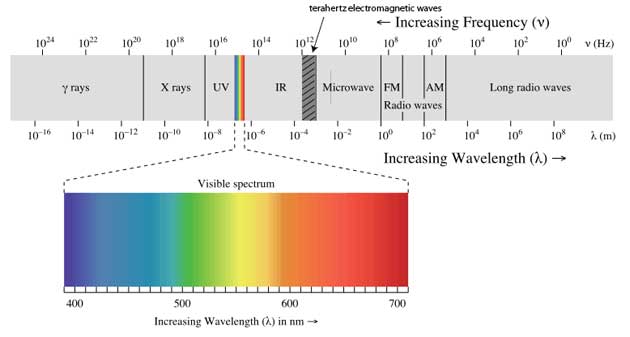
Electromagnetic spectrum showing where terahertz electromagnetic waves are located.
image link: http://en.wikipedia.org/wiki/File:EM_spectrum.svg
Image Credit: This file is licensed under the Creative Commons Attribution ShareAlike 3.0 License.
What makes terahertz radiation so interesting is that it can go through many materials like cloth, paper, plastic, wood, ceramic, fog, and even chocolate.3-6 They are able to use terahertz radiation to image paintings under paintings without harming the artwork in any way. They can also use it to look under plaster on buildings, see if there is an unwanted object in your chocolate, or to see if someone has weapons concealed under their clothing. It is often used in astronomy and environmental science to measure the presence of certain molecules. Some applications of terahertz radiation are used to detect and determine types of drugs and explosives.5,6 Terahertz radiation does not go through metal and is absorbed by water, so it does not easily go through many layers of human tissue (we are mainly water), or through metallic weapons. A portable terahertz laser has been created and is used for surveillance and security purposes.
The big deal about carbon nanotube cupcakes
If scientists are going to use terahertz radiation they need to be able to measure it. At the National Institute of Standards and Technology at Boulder, CO, Dr. Lehman's group is working on ways to measure properties of terahertz lasers. They decided to use nanotubes as a coating on a detector to try to enhance the detector's ability to measure the energy radiated on it by a terahertz laser. The best detector would be able to absorb all the energy radiated on it and transform it to something measurable, like an electric current. The idea of improving detectors has been going on for a long time. In 1898 scientists put soot on thermal detectors to increase their ability to absorb radiation. However, soot and other later coatings were not very good thermal conductors. Lehman's group decided to try carbon nanotubes. They grew vertically aligned, multi-walled (concentric single walled), carbon nanotubes of different lengths onto a silicon substrate. The lengths they tested were 0.04 mm (or 40 mm), 0.15 mm, and 1.5 mm.7
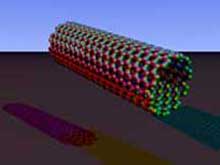 (a) |
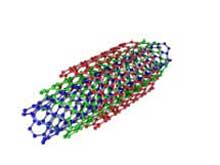 (b) |
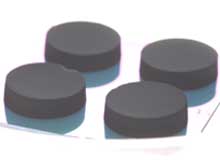 (c) |
|
(a) Single walled nanotube. Image Credit: This file is released into the public domain | ||
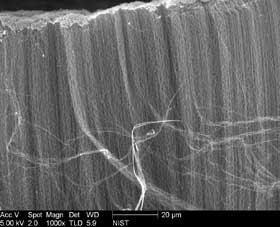
Scanning electron microscope (SEM) image of the vertically aligned multi-walled carbon nanotube cupcakes showing a side view of the tube array.
Image credit: John H. Lehman & Nathan Tomlin, NIST Boulder, CO
These "cupcakes" absorbed almost all the terahertz radiation from a laser with a frequency of 0.76 terahertz, which is in the far infrared region. It turns out that the longer the nanotubes were in the cupcake, the more laser light (radiation) it absorbed. Remember that these carbon nanotubes are just a coating on a detector. Their job is to enhance the detector. As these cupcakes absorb the laser light they warm up. They are also highly conductive, so they transfer almost all the heat energy they absorbed to the detector below them, with only a small amount getting transferred to the air surrounding them. One type of detector this group uses is a thermopile,8 which is made of multiple thermocouples. A thermocouple is nothing more than two different conducting materials (very specifically chosen and placed) that produce a potential difference (voltage) proportional to local temperature differences between the two materials. The potential difference results in a measurable electric current that is calibrated to the amount of radiation absorbed by the cupcake and transferred to the detector (thermopile). The other type of detector the group uses is a pyroelectric detector (made of lithium tantalate),2 which is constructed of crystal molecules whose dimensions change proportionally to the temperature, causing a change in the electric field within the crystal and a potential difference across the crystal. Again, the potential difference gives rise to a measurable electric current that can be calibrated to the amount of energy transferred to the detector.
Future research and applications
Measurement is fundamental to physics. Creating a better detector increases accuracy and precision in measurements taken. New detectors are always checked against current standard detectors. In the future new detector designs for improved measurements are planned. Before that can happen, further measurements on the current system needs to occur. Scientists are planning on determining how the absorption of terahertz radiation by these multi-walled carbon nanotube cupcakes is affected by polarization and other terahertz radiation frequencies.7 Dr. Lehman's groups is also investigating growing nanotubes on other substrates than silicon and growing them in complex shapes, such as inside a cone. The eventual development of improved detectors will be used in measuring many radiant energy on the detector in many different platforms such as: optical-fiber communication systems, photovoltaic and solar-thermal efficiency, satellite-based temperature sensors, as well as in the manufacturing of lasers.11
References, resources, and links
1. Ost, L., Extreme Darkness: Carbon Nanotube Forest Covers NIST's Ultra-dark Detector, From NIST Tech Beat: August 17, 2010
2. Ost, L., Piece of Cake: Arrays of Long Nanotubes May Help Measure Terahertz Laser Power, From NIST Tech Beat: July 19, 2011
4. Mueller, E. Terahertz radiation: Applications and sources, The Industrial Physicist, American Institute of Physics, pp 27-29, Aug/Sep 2003
5. Koch, M., Terahertz technology: A land to be discovered, pp 20-25, Optics and Photonics News, March 2007.
6. Steele, B., Terahertz chips could make scanners for medicine, Chronicle Online, Cornell University, 2 March 2011
7. Daukantas, P. "Cakes" of Carbon Nanotubes Could Measure Terahertz Power, Optics & Photonics News, November 2011.
8. Lehman, J, Deshpande, R. Rice, P. To, B, & Dillon, A, Carbon multi-walled nanotubes grown by HWCVD on a pyroelectric detector, Infrared Phys. Technol. 47 (2006) 246-250.
9. Thermopile
10. Thermocouple
11. Lehman, J. et al., Very Black Infrared Detector from VerticallyAligned Carbon Nanotubes and Electric-Field Poling of Lithium Tantalate, NanoLett. 2010 10, 3261-3266. DOI: 10.1021/nl100582j
H.M. Doss














